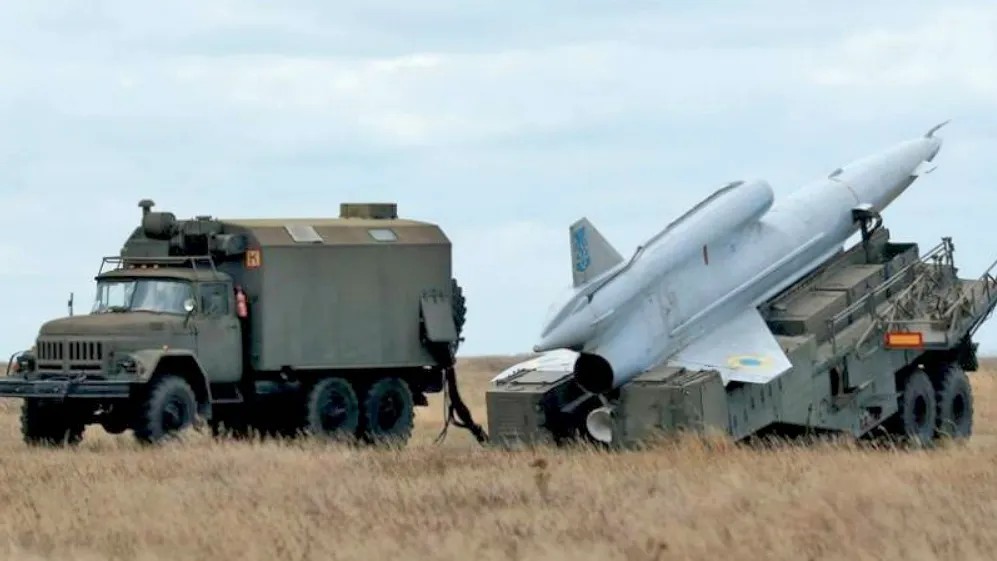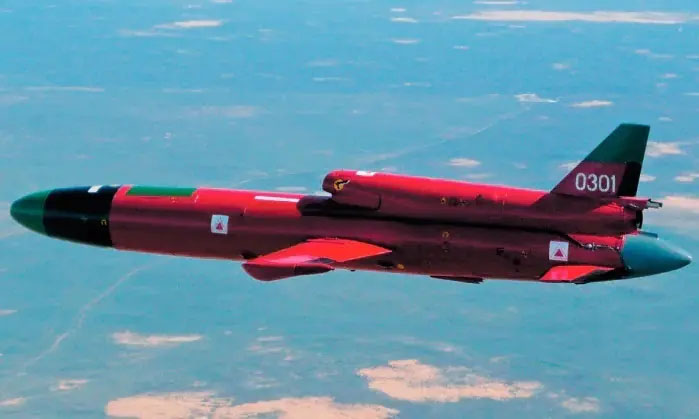Ukraine’s Flamingo missile is for blasting Russian factories

The Flamingo, a product of Kyiv-based manufacturer Fire Point, weighs in a staggering 6,000 kg. That’s four times what the American Tomahawk cruise missile weighs. The rocket-propelled Flamingo should be able to haul a 1,000-kg warhead over a distance of 3,000 km while under satellite and inertial guidance.
Speeding along at 950 km/hr, the ramp-launched missile should be able to avoid all but the best Russian air defenses. Ranging twice as far as the best current Ukrainian deep-strike munitions, and with a warhead that several times heavier, the Flamingo has the potential to significantly escalate Ukraine’s strategic bombardment campaign targeting Russian factories, air bases and oil refineries.
While the Flamingo’s existence has long been rumored, it wasn’t until this weekend that Associated Press journalist Efrem Lukatsky confirmed it—with a photo of two of the huge missiles on their trailers at a workshop somewhere in Ukraine.
If the Flamingo looks familiar, it’s because it’s apparently a development of the FP-5 missile from Emirati firm Milanion. The FP-5 itself seems to borrow heavily from a missile with a storied history in Soviet and Ukrainian service: the Tupolev Tu-141.
The 5,400-kg Tu-141 was a reconnaissance drone—a product of the Kharkiv Aviation Plant in Ukraine. Ranging 1,000 km under inertial guidance at a top speed of 1,000 km/hr, it carried cameras instead of explosives. When the Soviet Union collapsed in 1991, it left potentially dozens of Tu-141s behind in Ukraine along with the type’s assembly line.
A few of the 50-year-old Tu-141s were still flyable when Russia widened its war on Ukraine in February 2022. Enterprising Ukrainian technicians got to work repairing the old drones, testing their engines and replacing with cameras with warheads. They may also have added modern satellite navigation to complement or replace their old analogue inertial computers.

Crude cruise missiles
The rebuilt Tu-141s were some of Ukraine’s first deep-strike munitions. Following a difficult teething period that resulted in at least two Tu-141s crashing, the remaining drones attacked. On Oct. 7, 2022, Ukrainian drones—possibly Tu-141s—struck Shaykovka Air Base, 200 km from the Ukrainian border. There were reports of damage to two Tupolev Tu-22M bombers.
Subsequent drones raids on Dec. 5, 2022—possibly also the work of Tu-141s—targeted the bomber bases at Engels-2 and Dyagilevo, both 600 km from Ukraine. More drones hit Engels-2 on Dec. 26, 2022. By March 2023, the last few Tu-141s had crashed or been shot down, it seems. Soon, much more modern drones replaced the Tu-141s as Ukraine struck more targets inside Russia.
But these modern drones lack range and striking power. Arguably the best Ukrainian deep-strike drone, the propeller-driven, satellite-guided Ukroboronprom An-196, ranges 800 km with a 50-kg warhead. And it does so slowly, cruising at just 320 km/hr.
With their limited range and small warheads, the drones can damage the closest and most delicate Russian targets such as the distillation towers at oil refineries in western Russia. But they can’t do much to halt operations at bigger, more distant strategic facilities—for instance, the Shahed drone factory that sprawls across nearly 160,000 sq m in Yelabuga, 1,500 km from Ukraine.
A barrage of Flamingo missiles just might stand a chance of taking out the Shahed factory and similar hard targets. If Ukraine can afford to build the missiles in large numbers. It’s unclear how much a Flamingo costs, but it’s worth noting that most American and Russian cruise missiles set back their taxpayers more than $1 million per round.
It took German financing for Ukraine to ramp up production of the An-196, which costs around $200,000 per copy. Absent a big financial commitment from an ally, Kyiv may struggle to build up an arsenal of hundreds of Flamingos—which is what it might take to make a real dent in Russian industry in the regions currently beyond reach of Ukraine’s deep-strike munitions.

Did Ukraine just unleash its first Bars cruise missiles? A 500 km strike deep inside Russia suggests it

Thanks to your incredible support, we’ve raised 70% of our funding goal to launch a platform connecting Ukraine’s defense tech with the world – David vs. Goliath defense blog. It will support Ukrainian engineers who are creating innovative battlefield solutions and we are inviting you to join us on the journey.
Our platform will showcase the Ukrainian defense tech underdogs who are Ukraine’s hope to win in the war against Russia, giving them the much-needed visibility to connect them with crucial expertise, funding, and international support.
We’re one final push away from making this platform a reality.

